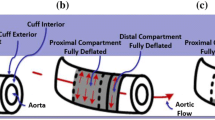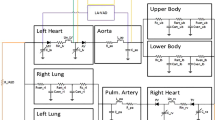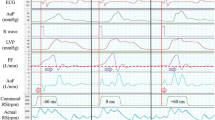Abstract
Continuous flow (CF) left ventricular assist devices (LVAD) support diminishes vascular pressure pulsatility. Despite its recent clinical success CF LVAD support has been associated with a higher incidence of gastrointestinal bleeding, aortic valve dysfunction and hemorrhagic strokes. To overcome this limitation, we are develo** algorithms to provide vascular pulsatility using a CF LVAD. The effects of timing and synchronizing the CF LVAD flow modulation to the native myocardium, modulation amplitude, and modulation widths were studied on the native ventricle and vasculature using a computer simulation model of the circulatory system simulating heart failure. A total of over 150 combinations of varying pulse widths, beat frequencies, time shifts, and amplitudes to modulate CF LVAD flow were tested. All control algorithms maintained a mean CF LVAD flow of 5.0 ± 0.1 L/min (full support) or 2.5 ± 0.1 L/min (partial support). These algorithms resulted in an increased arterial pressure pulsatility of up to 59 mmHg, reduced left ventricular external work (LVEW) by 10–75%, and increased myocardial perfusion by up to 44% from baseline heart failure condition. Importantly, reduction in LVEW and increase in pulsatility may be adjusted to user-defined values while maintaining the same average CF LVAD flow rate. These methods of CF LVAD flow modulation may enable tailored unloading of the native ventricle to provide rest and rehabilitation (maximal unloading to rest followed by gradual reloading to wean), which may promote sustainable myocardial recovery. Further, these LVAD flow modulation patterns may reduce the incidence of adverse events associated with the CF LVAD therapy by increasing vascular pulsatility.







Similar content being viewed by others
References
Akimoto, T., et al. Relationship of blood pressure and pump flow in an implantable centrifugal blood pump during hypertension. ASAIO J. 46(5):596–599, 2000.
Bearnson, G. B., et al. Pulsatile operation of a centrifugal ventricular assist device with magnetic bearings. ASAIO J. 42(5):M620–M624, 1996.
Birks, E. J., et al. Left ventricular assist device and drug therapy for the reversal of heart failure. N. Engl. J. Med. 355(18):1873–1884, 2006.
Bruckner, B. A., et al. Regression of fibrosis and hypertrophy in failing myocardium following mechanical circulatory support. J. Heart Lung Transplant. 20(4):457–464, 2001.
Cox, L. G., et al. A mathematical model to evaluate control strategies for mechanical circulatory support. Artif. Organs 33(8):593–603, 2009.
Crow, S., et al. Gastrointestinal bleeding rates in recipients of nonpulsatile and pulsatile left ventricular assist devices. J. Thorac. Cardiovasc. Surg. 137(1):208–215, 2009.
Dipla, K., et al. Myocyte recovery after mechanical circulatory support in humans with end-stage heart failure. Circulation 97(23):2316–2322, 1998.
Farrar, D. J., et al. Long-term follow-up of Thoratec ventricular assist device bridge-to-recovery patients successfully removed from support after recovery of ventricular function. J. Heart Lung Transplant. 21(5):516–521, 2002.
Frazier, O. H., et al. Initial clinical experience with the HeartMate II axial-flow left ventricular assist device. Tex. Heart Inst. J. 34(3):275–281, 2007.
Fukamachi, K., et al. An innovative, sensorless, pulsatile, continuous-flow total artificial heart: device design and initial in vitro study. J. Heart Lung Transplant. 29(1):13–20, 2010.
Giridharan, G. A., and M. Skliar. Control strategy for maintaining physiological perfusion with rotary blood pumps. Artif. Organs 27(7):639–648, 2003.
Giridharan, G. A., et al. Modeling and control of a brushless DC axial flow ventricular assist device. ASAIO J. 48(3):272–289, 2002.
Giridharan, G. A., et al. Left ventricular and myocardial perfusion responses to volume unloading and afterload reduction in a computer simulation. ASAIO J. 50(5):512–518, 2004.
Giridharan, G. A., et al. A computer model of the pediatric circulatory system for testing pediatric assist devices. ASAIO J. 53(1):74–81, 2007.
Heerdt, P. M., et al. Chronic unloading by left ventricular assist device reverses contractile dysfunction and alters gene expression in end-stage heart failure. Circulation 102(22):2713–2719, 2000.
Imachi, K., et al. The second and third model of the flow transformed pulsatile total artificial heart. ASAIO J. 38(3):M717–M721, 1992.
Khalil, H. A., et al. Induced pulsation of a continuous-flow total artificial heart in a mock circulatory system. J. Heart Lung Transplant. 29(5):568–573, 2010.
Koenig, S. C., et al. Human, bovine and porcine systematic vascular input impedances are not equivalent: implications for device testing and xenotransplantation in heart failure. J. Heart Lung Transplant. 27(12):1340–1347, 2008.
Letsou, G. V., et al. Improved left ventricular unloading and circulatory support with synchronized pulsatile left ventricular assistance compared with continuous-flow left ventricular assistance in an acute porcine left ventricular failure model. J. Thorac. Cardiovasc. Surg. 140(5):1181–1188, 2010.
Levin, H. R., et al. Reversal of chronic ventricular dilation in patients with end-stage cardiomyopathy by prolonged mechanical unloading. Circulation 91(11):2717–2720, 1995.
Mudd, J. O., et al. Fusion of aortic valve commissures in patients supported by a continuous axial flow left ventricular assist device. J. Heart Lung Transplant. 27(12):1269–1274, 2008.
Ogletree-Hughes, M. L., et al. Mechanical unloading restores beta-adrenergic responsiveness and reverses receptor downregulation in the failing human heart. Circulation 104(8):881–886, 2001.
Pantalos, G. M., et al. Characterization of an adult mock circulation for testing cardiac support devices. ASAIO J. 50(1):37–46, 2004.
Qian, K. X. Pulsatile impeller heart: a viable alternative to a problematic diaphragm heart. Med. Eng. Phys. 18(1):57–66, 1996.
Rose, E. A., et al. Long-term use of a left ventricular assist device for end-stage heart failure. N. Engl. J. Med. 345(20):1435–1443, 2001.
Shi, Y., P. V. Lawford, and D. R. Hose. Numerical modeling of hemodynamics with pulsatile impeller pump support. Ann. Biomed. Eng. 38(8):2621–2634, 2010.
Shiose, A., et al. Speed modulation of the continuous-flow total artificial heart to simulate a physiologic arterial pressure waveform. ASAIO J. 56(5):403–409, 2010.
Slaughter, M. S., et al. Advanced heart failure treated with continuous-flow left ventricular assist device. N. Engl. J. Med. 361(23):2241–2251, 2009.
Takashi, N., et al. Prolonged nonpulsatile left heart bypass with reduced systemic pulse pressure causes morphological changes in the aortic wall. Artif. Organs 22(5):405–410, 1998.
Thohan, V., et al. Cellular and hemodynamics responses of failing myocardium to continuous flow mechanical circulatory support using the DeBakey-Noon left ventricular assist device: a comparative analysis with pulsatile-type devices. J. Heart Lung Transplant. 24(5):566–575, 2005.
Torre-Amione, G., et al. Decreased expression of tumor necrosis factor-alpha in failing human myocardium after mechanical circulatory support: a potential mechanism for cardiac recovery. Circulation 100(11):1189–1193, 1999.
Travis, A. R., et al. Vascular pulsatility in patients with a pulsatile- or continuous-flow ventricular assist device. J. Thorac. Cardiovasc. Surg. 133(2):517–524, 2007.
Vandenberghe, S., et al. Unloading effect of a rotary blood pump assessed by mathematical modeling. Artif. Organs 27(12):1094–1101, 2003.
Vandenberghe, S., et al. Hemodynamic modes of ventricular assist with a rotary blood pump: continuous, pulsatile, and failure. ASAIO J. 51(6):711–718, 2005.
Voigt, O., R. J. Benkowski, and G. F. Morello. Suction detection for the MicroMed DeBakey left ventricular assist device. ASAIO J. 51(4):321–328, 2005.
Yuhki, A., et al. Detection of suction and regurgitation of the implantable centrifugal pump based on the motor current waveform analysis and its application to optimization of pump flow. Artif. Organs 23(6):532–537, 1999.
Zafeiridis, A., et al. Regression of cellular hypertrophy after left ventricular assist device support. Circulation 98(7):656–662, 1998.
Acknowledgment
The research was funded by a National Scientist Development Grant from the American Heart Association (0730319N) and by the University of Louisville Clinical and Translational Science Pilot Grant Program award.
Author information
Authors and Affiliations
Corresponding author
Additional information
Associate Editor John Timothy Baldwin oversaw the review of this article.
Rights and permissions
About this article
Cite this article
Ising, M., Warren, S., Sobieski, M.A. et al. Flow Modulation Algorithms for Continuous Flow Left Ventricular Assist Devices to Increase Vascular Pulsatility: A Computer Simulation Study. Cardiovasc Eng Tech 2, 90–100 (2011). https://doi.org/10.1007/s13239-011-0042-x
Received:
Accepted:
Published:
Issue Date:
DOI: https://doi.org/10.1007/s13239-011-0042-x




